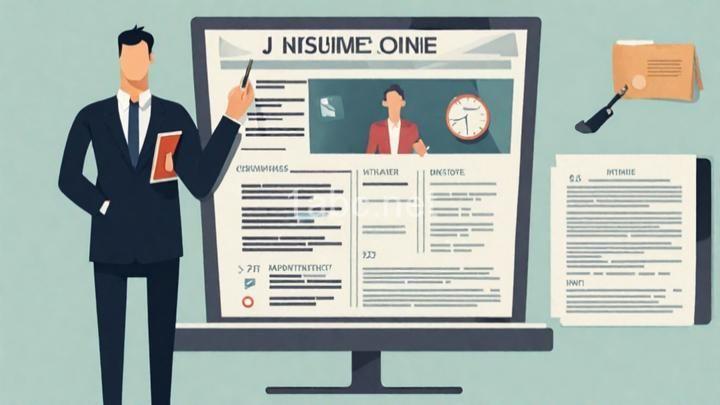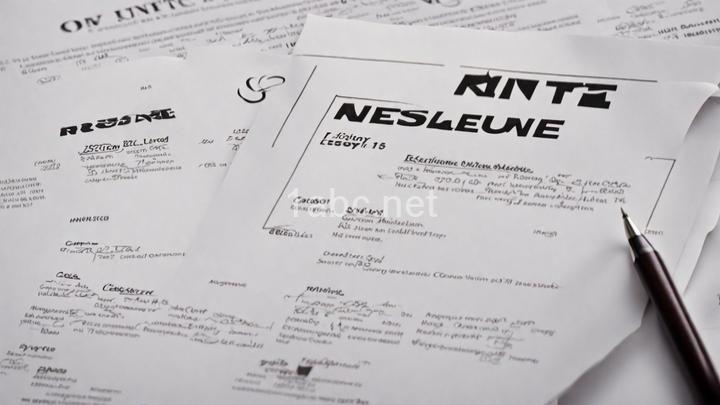The Art of Tailoring Your Resume to Get Noticed

Introduction:
Hello, dear readers! Welcome to the world of resumes, where a well-crafted document can make all the difference in landing your dream job. In this blog post, we will explore the art of tailoring your resume to get noticed by employers. We'll dive into the importance of understanding job requirements, highlighting relevant skills and experience, customizing your resume format, optimizing keywords for Applicant Tracking Systems (ATS), and showcasing achievements and results. So, let's get started on this journey to crafting an attention-grabbing resume!
Section 1: Understanding the Job Requirements
To begin our exploration, it is crucial to emphasize the significance of thoroughly reading and understanding the job description. Each job posting is unique and carries specific requirements that you must address in your resume. Take the time to analyze the description and identify key skills, qualifications, and experience sought by the employer. This will serve as your roadmap for tailoring your resume effectively.
When analyzing the job requirements, pay attention to keywords and phrases that are frequently mentioned. These are usually indicators of the employer's priorities. By incorporating these keywords into your resume, you increase the chances of aligning your skills and qualifications with what the employer is seeking.
Section 2: Highlighting Relevant Skills and Experience
Once you have a clear understanding of the job requirements, it's time to showcase your relevant skills and experience. Focus on selecting and prioritizing information that directly relates to the job you are applying for. Highlighting your most relevant qualifications will grab the attention of recruiters and increase your chances of getting noticed.
Consider using a skills-based resume format, where your skills and accomplishments take center stage. This format allows you to emphasize your strengths and demonstrate how they align with the job requirements. Another effective approach is to create a professional summary or profile at the beginning of your resume, where you can succinctly highlight your most relevant skills and experience.
Section 3: Customizing Your Resume Format
Beyond content, customizing the format of your resume can enhance its readability and make a lasting impact on employers. Begin by strategically organizing sections based on their relevance to the desired position. Place the most relevant information at the top, ensuring that it catches the recruiter's attention immediately.
To improve visual appeal and readability, use bullet points to present your accomplishments and responsibilities. This makes it easier for recruiters to scan your resume quickly. Additionally, utilize headings and subheadings to create a clear and organized structure. A well-formatted resume not only showcases your qualifications but also reflects your attention to detail and professionalism.
Section 4: Optimizing Keywords for Applicant Tracking Systems (ATS)
In today's digital age, Applicant Tracking Systems (ATS) play a significant role in the recruitment process. These systems are designed to scan resumes for specific keywords and rank them based on relevance. To increase your chances of getting past the initial ATS screening, it is crucial to optimize your resume with relevant keywords.
First, identify the keywords used in the job description. These can include specific skills, qualifications, software programs, or industry-related terms. Integrate these keywords naturally throughout your resume, ensuring that they appear in both the skills and experience sections. However, be cautious not to overuse keywords, as it may appear unnatural or spammy.
Section 5: Showcasing Achievements and Results
Employers are not only interested in your skills and experience but also in the impact you have made in your previous roles. Quantifying your achievements and showcasing measurable results is a powerful way to stand out from the competition.
When highlighting your accomplishments, focus on specific examples that demonstrate your abilities. Instead of simply stating your responsibilities, quantify your achievements whenever possible. For example, instead of saying "Managed a team of sales associates," say "Successfully led a team of 10 sales associates, resulting in a 15% increase in revenue." This showcases your ability to achieve tangible results and adds credibility to your resume.
Conclusion:
Congratulations! You have reached the end of our journey through the art of tailoring your resume to get noticed. We have explored the importance of understanding job requirements, highlighting relevant skills and experience, customizing your resume format, optimizing keywords for Applicant Tracking Systems (ATS), and showcasing achievements and results. Remember, tailoring your resume for each job application is essential to increase your chances of getting noticed by employers.
Now it's time to put these strategies into practice. Take the knowledge you have gained and apply it to your own resume. Remember to invest time and effort into crafting a tailored resume that reflects who you are and what you can bring to the table. Good luck with your job search, and may your customized resume open doors to exciting opportunities!
FREQUENTLY ASKED QUESTIONS
What is The Art of Tailoring Your Resume to Get Noticed?
The art of tailoring your resume to get noticed is all about customizing your resume to match the specific requirements of the job you're applying for. It's not enough to simply have a generic resume that you send out to every employer. Instead, you need to take the time to carefully analyze the job description and identify the key skills, experiences, and qualifications that the employer is looking for.Once you have a clear understanding of what the employer wants, you can then tailor your resume to highlight those specific aspects of your background. This might involve reordering your bullet points, emphasizing certain accomplishments, or even adding new sections to your resume.
For example, if the job description mentions that the employer is looking for someone with strong project management skills, you could create a separate section on your resume dedicated to showcasing your project management experience. You could list specific projects you've completed, highlight any relevant certifications or training you've received, and provide concrete examples of how your project management skills have benefited previous employers.
Another important aspect of tailoring your resume is using keywords. Many employers use applicant tracking systems (ATS) to screen resumes, and these systems often search for specific keywords that are relevant to the job. By incorporating these keywords into your resume, you can increase your chances of getting past the initial screening process.
Overall, the art of tailoring your resume involves carefully analyzing the job description, customizing your resume to match the employer's needs, and using keywords to optimize your chances of getting noticed. Taking the time to tailor your resume can make a significant difference in your job search and increase your chances of landing an interview.
Why is tailoring your resume important?
Tailoring your resume is important because it allows you to showcase your skills, experience, and qualifications in a way that is specifically targeted to the job you are applying for. When you customize your resume to match the requirements and preferences of the employer, you increase your chances of standing out from other applicants and getting called for an interview.By tailoring your resume, you can highlight the most relevant aspects of your background that align with the job description. This means emphasizing the skills and experiences that directly relate to the position you are applying for and downplaying or omitting information that is not as pertinent. This helps the employer quickly see how you are a strong fit for the role.
Moreover, tailoring your resume demonstrates your genuine interest in the job and the company. It shows that you have taken the time to research and understand the organization's needs and have made an effort to customize your application accordingly. This level of attention to detail and personalization can make a positive impression on hiring managers.
Additionally, tailoring your resume can help overcome any potential gaps or discrepancies in your work history. If you have diverse experiences or a non-linear career path, tailoring allows you to highlight transferable skills or specific achievements that are relevant to the position, even if they are not your most recent experiences.
Overall, tailoring your resume is essential because it increases the likelihood of getting noticed by employers, demonstrates your genuine interest and fit for the job, and allows you to strategically highlight your most relevant qualifications. So, take the time to tailor your resume for each job application and make a memorable impression on hiring managers.
How can I identify the key requirements for a job?
To identify the key requirements for a job, there are a few steps you can take. First, carefully review the job description provided by the employer. This will outline the specific skills, qualifications, and experience they are seeking in a candidate. Pay close attention to any mandatory requirements or preferred qualifications mentioned.Next, conduct research on the company and industry to gain a deeper understanding of the skills and qualities that are valued in that particular field. Look for common trends and patterns in job postings for similar positions to get a sense of the typical requirements.
Additionally, reach out to professionals who are already working in the industry or similar roles. Networking can provide valuable insights into the key requirements and expectations employers have for job candidates.
It's also important to consider any relevant certifications or specialized training that may be necessary for the job. Certain positions may require specific technical skills or knowledge that can be acquired through professional development courses or certifications.
Overall, by thoroughly reviewing job descriptions, researching the industry, networking, and considering any necessary certifications, you can effectively identify the key requirements for a job. This will help you tailor your application and showcase your qualifications in the best possible light.
What are some tips for tailoring my resume effectively?
When it comes to tailoring your resume effectively, there are a few tips that can make a big difference. Here are some suggestions to help you showcase your skills and experiences in the best possible way:
-
Research the job: Before you start tailoring your resume, take the time to thoroughly understand the job description and requirements. This will give you insight into what the employer is looking for and help you highlight relevant skills and experiences.
-
Customize your objective statement: Your objective statement is the first thing employers see, so make sure it aligns with the position you're applying for. Tailor it to emphasize your interest in the specific role and how you can contribute to the company's goals.
-
Match your skills to the job requirements: Review the job description and identify the key skills and qualifications they are seeking. Then, go through your resume and ensure that your skills align with those requirements. Highlight the most relevant skills in your summary, work experience, and skills section.
-
Show quantifiable achievements: Use numbers, percentages, or specific outcomes to demonstrate your accomplishments. This helps employers see the impact you've made in previous roles and gives them a clear picture of what you can bring to their organization.
-
Use keywords: Many employers use applicant tracking systems (ATS) to scan resumes for specific keywords. Include relevant industry-specific keywords throughout your resume to increase your chances of getting past the initial screening process.
-
Tailor your work experience: Customize your bullet points under each job to highlight relevant responsibilities and achievements. Focus on accomplishments that are most relevant to the position you're applying for.
-
Highlight relevant coursework or certifications: If you're a recent graduate or have taken relevant courses or certifications, include them in a separate section. This can help demonstrate your commitment to ongoing learning and showcase your knowledge in specific areas.
-
Proofread and format: Take the time to proofread your resume for any spelling or grammatical errors. Additionally, ensure that your resume is well-formatted and easy to read. Use bullet points, headings, and a clean layout to make it visually appealing.
Remember, tailoring your resume is all about showcasing your skills and experiences in a way that is relevant to the specific job you're applying for. By following these tips, you'll increase your chances of standing out to potential employers. Good luck!



